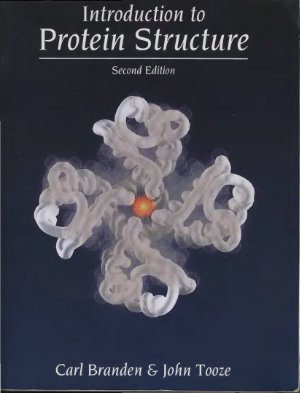2nd ed. - Garland Publishing, 1999. - 410 p.
The determination of the atomic structures of proteins has seen an enormous increase in impetus since the first edition of this book was published in 1991. The number of new structures reported is close to doubling each year. Tech-nical advances—for example the increased availability of synchrotron x-ray beams and methods for freezing crystals so as to reduce radiation damage to them, the development of multidimensional NMR and NMR machines with ever more powerful magnetic fields, and the exploitation of gene cloning, sequencing and expression systems have all contributed to the growth of pro-tein structure determination. On the one hand, it is becoming increasingly easy to obtain relatively large amounts of naturally rare proteins, on the other hand the crystallographers can work with ever smaller crystals.
The fundamental tenet of molecular biology, namely that one cannot really understand biological reactions without understanding the structure of the participating molecules, is at last being vindicated. As the database of known protein structures rapidly expands, so does the range of biological pathways about which we can ask meaningful questions at close to atomic levels of resolution. An understanding of the principles of protein structure is becoming of ever widening significance to molecular biology.
The growth in the interest in high-resolution protein structure over the past decade and the reception of the first edition have encouraged us to pre-pare a new edition of this book. Universities are devoting more time to cours-es specifically on protein structure, or increasing the amount of time given to protein structure in more generally based biology' and biochemistry courses. We hope that this new edition of Introduction to Protein Structure will prove useful both to teachers and students.
In 1988 when we began writing the first edition, about 250 protein struc-tures had been determined to medium to high resolution and in those days a professional protein crystallographer was familiar with most of them. We were not therefore faced with a severe problem of what to leave out as we wrote. Today, the coordinates of over 6500 proteins have been deposited in the Protein Data Bank at Rrookhaven, New York. Both the number of struc-tures and the variety of biological systems to which they relate are so high that the field of protein structure is becoming more fragmented and special-ized. It is becoming increasingly difficult to keep sight of the wood amongst so many trees. The question of what to include and what to omit is, for today's authors, crucially important. We have tried to resist the temptation to describe more and more proteins, adding detail but not increasing under-standing of the basic concepts. This edition is inescapably a little larger than its predecessor, but to contain the increase in size we have deleted two chap-ters while adding four. We run the risk of disappointing not a few structural biologists whose favourite proteins are not mentioned. To them we apologize and ask for their understanding.
The determination of the atomic structures of proteins has seen an enormous increase in impetus since the first edition of this book was published in 1991. The number of new structures reported is close to doubling each year. Tech-nical advances—for example the increased availability of synchrotron x-ray beams and methods for freezing crystals so as to reduce radiation damage to them, the development of multidimensional NMR and NMR machines with ever more powerful magnetic fields, and the exploitation of gene cloning, sequencing and expression systems have all contributed to the growth of pro-tein structure determination. On the one hand, it is becoming increasingly easy to obtain relatively large amounts of naturally rare proteins, on the other hand the crystallographers can work with ever smaller crystals.
The fundamental tenet of molecular biology, namely that one cannot really understand biological reactions without understanding the structure of the participating molecules, is at last being vindicated. As the database of known protein structures rapidly expands, so does the range of biological pathways about which we can ask meaningful questions at close to atomic levels of resolution. An understanding of the principles of protein structure is becoming of ever widening significance to molecular biology.
The growth in the interest in high-resolution protein structure over the past decade and the reception of the first edition have encouraged us to pre-pare a new edition of this book. Universities are devoting more time to cours-es specifically on protein structure, or increasing the amount of time given to protein structure in more generally based biology' and biochemistry courses. We hope that this new edition of Introduction to Protein Structure will prove useful both to teachers and students.
In 1988 when we began writing the first edition, about 250 protein struc-tures had been determined to medium to high resolution and in those days a professional protein crystallographer was familiar with most of them. We were not therefore faced with a severe problem of what to leave out as we wrote. Today, the coordinates of over 6500 proteins have been deposited in the Protein Data Bank at Rrookhaven, New York. Both the number of struc-tures and the variety of biological systems to which they relate are so high that the field of protein structure is becoming more fragmented and special-ized. It is becoming increasingly difficult to keep sight of the wood amongst so many trees. The question of what to include and what to omit is, for today's authors, crucially important. We have tried to resist the temptation to describe more and more proteins, adding detail but not increasing under-standing of the basic concepts. This edition is inescapably a little larger than its predecessor, but to contain the increase in size we have deleted two chap-ters while adding four. We run the risk of disappointing not a few structural biologists whose favourite proteins are not mentioned. To them we apologize and ask for their understanding.

